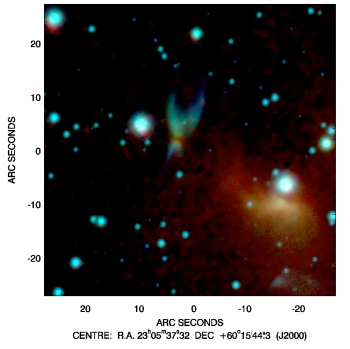| EPoS Contribution |
|
A massive, rotating disk around an isolated, young, massive(?) star
Sascha P. Quanz Institute for Astronomy, ETH Zurich, Zurich, Switzerland | |
| We report the detection of a large disk-like structure surrounding a potential massive young stellar object. High-resolution NIR images in the J, H, and Ks filter show a bipolar reflection nebula intersected by a dark lane suggesting an edge-on view of a circumstellar disk. Spitzer/IRAC data reveal that the central source is first visible in the second channel at 4.5 micron at shorter wavelengths the dust column density and thus the extinction is to high and prevent a detection of the central object. Single-dish bolometer measurements with MAMBO II resulted in a flux of ~11 mJy at 1.2 mm dust continuum, and a velocity of rest of ~51 km/s was detected at the SMT in CO(3-2). The latter one is in agreement with measurement for nearby HII regions suggesting a similar distance of 3-5 kpc. Follow-up observations with the SMA detected - but not resolved - the object at 1.3 mm in dust continuum with a beam of ~4 arcsec. The flux peak coincides perfectly with the center of the dark lane seen in the NIR images confirming it to be a compact dusty object. Simultaneous measurements of the 12CO/C18O line emission revealed a blue-shifted outflow in CO(2-1) overlaying with the northern reflection nebula. The integrated line emission of C18O has an elongated, disk-like shape and is perpendicular to the outflow. The line-width FWHM of this emission is very narrow (~0.8 km/s) and although it is only detected in 2 channels these show a clear velocity shift indicating rotation of the gas. Given the uncertainties in the distance the object's spatial extent is >10000 AU and several solar masses of gas are contained within the disk-like structure. A first radiative transfer model suggests that an intermediate to high-mass young stellar object resides in the center. Interestingly, the object appears to be rather isolated and not confined to a young stellar cluster as most young massive stars. We speculate that this object is the intermediate/high-mass counterpart to typical Class II sources in low-mass star formation seen edge-on hinting at a very similar formation process for all stars over a wide mass range. | |
 | |
| Caption: Color composite of the massive disk consisting of H (blue), Ks (green) and IRAC 4.5 micron (red). While the bipolar reflection nebula is only seen in scattered light in the H and Ks band, the IRAC filter nicely traces the disk intersecting the nebula. Seen at a distance of 3.5 kpc the physical size of the disk appears to exceed 10,000 AU. The dust continuum emission at 1.3mm (not shown here) coincides perfectly with the dark lane seen here. | |
| Collaborators: H. Beuther, MPIA, Germany J. Steinacker, MPIA/Observatoire de Paris, Germany/France T. Henning, MPIA, Germany H. Linz, MPIA, Germany O. Krause, MPIA, Germany S. M. Birkmann, ESA/ESTEC, The Netherlands Q. Zhang, CfA, USA |
Suggested Session:
Early Phases of Disks, Massive Stars |

